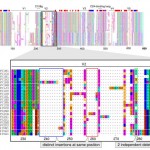 I am once again drawn to research from a team at the University of Westminster, a renowned institution that doles out so-called science degrees in homeopathy. This time the paper in question, published in the inaugural issue of the International Journal of Food Safety, Nutrition and Public Health (2008, vol 1, issue 1, pp 16-32) is on that perennial favourite: what to do about the obesity epidemic.
I am once again drawn to research from a team at the University of Westminster, a renowned institution that doles out so-called science degrees in homeopathy. This time the paper in question, published in the inaugural issue of the International Journal of Food Safety, Nutrition and Public Health (2008, vol 1, issue 1, pp 16-32) is on that perennial favourite: what to do about the obesity epidemic.
Ihab Tewfik, a senior lecturer in the School of Biosciences, at Westminster, reports that “the prevalence and severity of people suffering from obesity has increased markedly worldwide,” and adds that “The WHO declared obesity a ‘crisis of epidemic proportion’.” Nothing of which I can be too critical in those statements, except for one small point.
While obesity and the diseases and disorders for which it is purportedly a risk factor – type II diabetes, hypertension, hyperlipidemia, atherosclerosis, cardiovascular disease, stroke, and heart attack – are almost certainly on the increase in North America, Western Europe, and pockets of the Pacific Rim, the use of the term “worldwide” is rather ironic. This is especially true given that the WHO and other international organizations consistently report massive cases of disease, malnourishment and poor water supply across great tracts of the earth’s surface from Africa and South America to Asia and the former Soviet Union.
Anyway, Tewfik and colleagues have proposed a conceptual framework for a three-year intervention programme that could be adapted to the prevention of childhood obesity, which is a growing problem in many parts of the world, if not quite worldwide.
Ironically, they have named the framework, with one of those shoehorned acronyms, as CHOP, for Childhood Obesity Prevention and explain their approach as follows:
The approach is based on a behaviour modification model without giving foods. Family, school and children are essential counterparts to achieve meaningful improvement. Advocated by policies makers and embraced with favourite environmental factors, CHOP programme could be the conceptual framework for nutrition intervention that can be effectively integrated within the national health framework to attain public health goals.
Apparently, what this boils down to is giving children healthy foods, increasing physical activity and workout limits, limited TV and other screen times, implementing a non-food reward system, and allowing self-monitoring. As part of this approach schools will intervene in teaching children that they should eat five portions of fruit and vegetables each day, that they should cut the amount of fat they eat, limit their screen time and be active every day.
It all sounds like good, solid advice. Indeed, it’s the kind of advice the medical profession, nannyish governments, and even grandparents, have been offering for decades. Unfortunately, growing children are notoriously reluctant to take advice, especially when it comes to avoiding sweets and crisps, eating their greens, and switching off the Playstation (other gaming consoles are available).
The Westminster researchers, however, suggest their CHOP system would be convenient once the appropriate team, policies and resources have been successfully assembled. One has to wonder at a cost to whom these resources might be assembled. They do concede that, “In some circumstances this conceptual framework may be regarded to be too ambitious to attempt de novo within three years especially in some developing countries, where lack of access to health care, to drinkable water, to food, to education and housing is prevalent.”
It’s probably not necessary to implement it in places where food is in limited supply, surely. But, even in apparently developed nations, I’d suggest that costs will be severely prohibitive while children will be reluctant to partake (what positive rewards will replace treats and screen time?). Moreover, by their own admission, obesity is on a rapid climb among adults too and one has to wonder how these resources will be applied to persuade parents and carers of increasingly obese children will themselves be persuaded to take part if they do not appreciate the potential benefits.
Tewfik, I. (2008). Childhood Obesity Prevention (CHOP) programme: a conceptual framework for nutrition intervention. International Journal of Food Safety, Nutrition and Public Health, 1(1), 16. DOI: 10.1504/IJFSNPH.2008.018853
 I’ve got some wide-ranging research to report in this week’s SpectroscopyNOW, including mineral tests, colour MRI, the Agent Smith of prions, and a new approach to spotting doped athletes.
I’ve got some wide-ranging research to report in this week’s SpectroscopyNOW, including mineral tests, colour MRI, the Agent Smith of prions, and a new approach to spotting doped athletes. Sciencebase readers will likely be aware that when I cite a research paper, I usually use the DOI system, the Digital Object Identifier. This acts like a redirect service taking a unique number, which might look like this assigned to each research paper by its publisher and passing it to a server that works out where the actual paper is on the web.
Sciencebase readers will likely be aware that when I cite a research paper, I usually use the DOI system, the Digital Object Identifier. This acts like a redirect service taking a unique number, which might look like this assigned to each research paper by its publisher and passing it to a server that works out where the actual paper is on the web. I wrote about the
I wrote about the  Several years ago, I was called on by a multinational producer of hygiene, food, and cleaning products to pay a visit to their research and information centre. My role was to play editorial consultant for content for their new Intranet.
Several years ago, I was called on by a multinational producer of hygiene, food, and cleaning products to pay a visit to their research and information centre. My role was to play editorial consultant for content for their new Intranet. Genetic disease is a complicated affair. Scientists have spent years trying to find genetic markers for diseases as diverse as asthma, arthritis and cardiovascular disease. The trouble with such complex diseases is that they are none of them simply a manifestation of a genetic issue. They involve multiple genes, various other factors within the body and, of course, environmental factors outside the body.
Genetic disease is a complicated affair. Scientists have spent years trying to find genetic markers for diseases as diverse as asthma, arthritis and cardiovascular disease. The trouble with such complex diseases is that they are none of them simply a manifestation of a genetic issue. They involve multiple genes, various other factors within the body and, of course, environmental factors outside the body. I’m not entirely convinced that bird flu (avian influenza) is going to be the next big emergent disease that will wipe out thousands, if not millions, of people across the globe. SARS, after all, had nothing to do with avians, nor does HIV, and certainly not malaria, tuberculosis, MRSA, Escherichia coli O157, or any of dozens of virulent strains of disease that have and are killing millions of people.
I’m not entirely convinced that bird flu (avian influenza) is going to be the next big emergent disease that will wipe out thousands, if not millions, of people across the globe. SARS, after all, had nothing to do with avians, nor does HIV, and certainly not malaria, tuberculosis, MRSA, Escherichia coli O157, or any of dozens of virulent strains of disease that have and are killing millions of people. I am once again drawn to research from a team at the University of Westminster, a renowned institution that doles out so-called science degrees in homeopathy. This time the paper in question, published in the inaugural issue of the International Journal of Food Safety, Nutrition and Public Health (2008, vol 1, issue 1, pp 16-32) is on that perennial favourite: what to do about the
I am once again drawn to research from a team at the University of Westminster, a renowned institution that doles out so-called science degrees in homeopathy. This time the paper in question, published in the inaugural issue of the International Journal of Food Safety, Nutrition and Public Health (2008, vol 1, issue 1, pp 16-32) is on that perennial favourite: what to do about the  Evolutionary science needs debugging. Apparently, there are a few issues that cannot be resolved with any precision when one asks questions like: What makes a human different from a chimp? Apparently, at the level of genetic sequences, systematic errors creep into any analysis, distorting our ancestry.
Evolutionary science needs debugging. Apparently, there are a few issues that cannot be resolved with any precision when one asks questions like: What makes a human different from a chimp? Apparently, at the level of genetic sequences, systematic errors creep into any analysis, distorting our ancestry.
